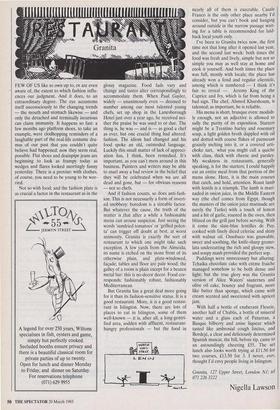■ $.
FEW OF US like to own up to, or are even aware of, the extent to which fashion influ- ences our judgment. And it does, to an extraordinary degree. The eye accustoms itself unconsciously to the changing trends — the mouth and stomach likewise — and only the detached and terminally incurious can claim immunity. It happens so fast: a few months ago platform shoes, to take an example, were clodhopping reminders of a laughable part of the real-life costume dra- mas of our past that you couldn't quite believe had happened; now they seem real, possible. Flat shoes and drainpipe jeans are beginning to look as frumpy today as wedges and flares looked snortingly funny yesterday. There is a proviso: with clothes, of course, you need to be young to be wor- ried.
Not so with food; and the fashion plate is as crucial a factor in the restaurant as in the glossy magazine. Food fads vary and change and tastes alter correspondingly to accommodate them. When Paul Gayler, widely — unanimously even — deemed to number among our most talented young chefs, set up shop in the Lanesborough Hotel just over a year ago, he received nei- ther the praise he was used to or due. The thing is, he was — and is — as good a chef as ever, but one crucial thing had altered: fashion. The idiom had changed and his food spoke an old, outmoded language. Luckily this small matter of lack of appreci- ation has, I think, been remedied. It's important, as you can't mess around in this business. Painters and writers may be able to snarl away a bad review in the belief that they will be celebrated when wo are all dead and gone, but — for obvious reasons — not so chefs.
And if fashion counts, so does anti-fash- ion. This is not necessarily a form of invert- ed snobbery: boredom is a sizeable factor. But whatever the cause, the truth of the matter is _that after a while a fashionable menu can arouse suspicion. Just seeing the words `sundried tomatoes' or 'grilled polen- ta' can trigger off doubt at best, at worst animosity. Granita is exactly the sort of restaurant to which one might take such exception. A few yards from the Almeida, its name is etched on the stone front of its otherwise plain, and plate-windowed, façade; tables and floor are pale wood; the galley of a room is plain except for a beaten metal bar: this is no-decor decor. Food cor- responds: fashionably robust, fashionably Mediterranean.
But Granita has a great deal more going for it than its fashion-sensitive status. It is a good restaurant. More, it is a good restau- rant in Islington. Now, there are lots of places to eat in Islington, some of them well-known — it is, after all, a long-gentri- fied area, sodden with affluent, restaurant- hungry professionals — but the food in nearly all of them is execrable. Casale Franco is the only other place nearby I'd consider, but you can't book and hanging around outside in the narrow passage wait- ing for a table is recommended for laid- back local youth only.
I've been to Granita twice now, the first time not that long after it opened last year, and the second last week: both times the food was fresh and lively, simple but not so simple you may as well stay at home and cook it yourself. And both times the place was full, mostly with locals; the place has already won a fond and regular clientele, among which is numbered — I think it's fair to reveal — Jeremy King of the Caprice and Ivy, which is far from being a bad sign. The chef, Ahmed Kharshoum, is talented; as important, he is reliable.
His menu is short, brusque even: modish- ly enough, not an adjective is allowed to sully the purity of its exposition. Starters might be a Trentino barley and rosemary soup, a light golden broth dappled with oil and dotted with coarse flakes of parmesan grainily melting into it, or a covered arti- choke tart, what you might call a quiche with class, thick with cheese and parsley. My weakness in restaurants, generally speaking, is for the starters; I could happily eat an entire meal from that portion of the menu alone. Here, it is the main courses that catch, and hold, attention. Roast lamb with lentils is a triumph. The lamb is mari- naded in onion juice, in the Middle Eastern way (the chef comes from Egypt, though the masters of the onion juice marinade are surely the Turks) with a touch of lemon and a hit of garlic, roasted in the oven, then blitzed on the grill just before serving. With it come the slate-blue lentilles de Puy, cooked with finely diced celeriac and shiny with walnut oil. Ossobuco was gnawable, sweet and soothing, the knife-sharp gremo- lata undercutting the rich and gloopy stew, and soupy mash provided the perfect sop.
Puddings were unnecessary but alluring: Tchaika chocolate cake with creme fraiche managed somehow to be both dense and light; but the true glory was the Granita version of Alice Waters' sauternes and olive oil cake, bouncy and fragrant, more like batter than sponge, which came with cream scented and sweetened with apricot jam.
With half a bottle of exuberant Fleurie, another half of Chablis, a bottle of mineral water and a glass each of Paxarran, a Basque bilberry and anise liqueur which tasted like ambrosial cough linctus, and Bordeje, a clear and deliciously determined Spanish muscat, the bill, before tip, came to an astoundingly cheering £55. The set lunch also looks worth trying at £11.50 for two courses, £13.50 for 3. I never, ever, thought I'd envy people living in Islington.
Granita, 127 Upper Street, London N1; tel 071 226 3222
Nigella Lawson


























































 Previous page
Previous page